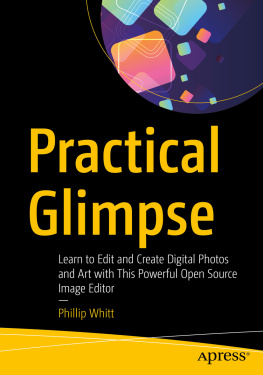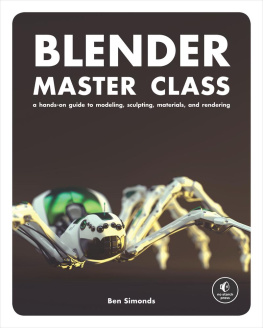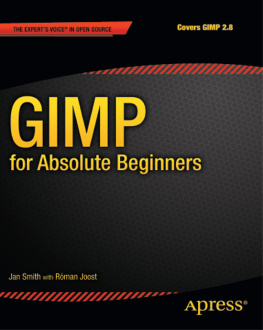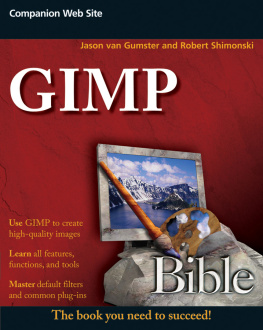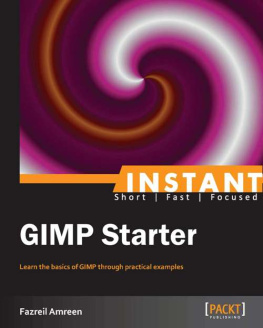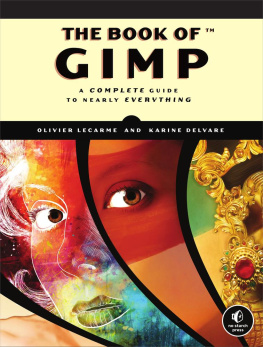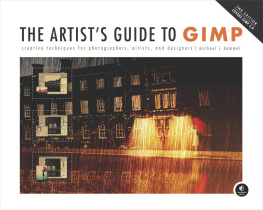Rolf Steinort is a science teacher in Berlin, Germany. As an amateur photographer before autofocus was invented and a Linux user at the time Tux became its mascot, he is naturally a longtime GIMP user. Since 2007, he has produced Meet the GIMP ( http://meetthegimp.org/ ), a video tutorial podcast about GIMP and other open source graphic programs.
Acknowledgments
Theres no such thing as a one-man project, and this book is no exception. While the tutorials are mine, the ideas and motivations come from all over the world, from many artists and designers with much greater talent that Ill ever possess. To them, I owe my modest artistic accomplishments.
But even before these tutorials could be created, someone had to build the tools. To the GIMP Development Team, with specific thanks to Sven Neumann and Michael Natterer for keeping the project going for many years, I thank you for your years of dedication and hard work.
I owe the staff at Linux Format (past and present) a heartfelt thanks for publishing my GIMP tutorials series long enough for me to come up with the ideas in this book.
Of course, my biggest thanks are due to Bill Pollock at No Starch Press for eagerly accepting the idea for this book. And extra thanks go to the rest of the gang at No Starch Press: Alison Law and Tyler Ortman for their editing, and Leigh Poehler and Rachel Waner on the sales and marketing team. Thanks to Rolf Steinort from Meet The Gimp! ( http://meetthegimp.org/ ) for his technical reviews, video clarifications, and assistance with learning new features in GIMP 2.8. Without all their great help this would be nothing more than a bunch of text files and screenshots.
Thanks to Greg Martin for graciously allowing me to create a GIMP version of his original Photoshop star field tutorial ( http://www.gallery.artofgregmartin.com/tuts_arts/making_a_star_field.html ).
Additional thanks to my mom for once again letting me use a photo of her from her high school days in the photo restoration chapter. I know I wouldnt want my high school pictures used for anything except fireplace kindling.
Credits
Selected images appear from the following royalty-free collections:
BigStockPhoto.comhttp://www.bigstockphoto.com/
iStockphoto.comhttp://www.istockphoto.com/
PDPhoto.orghttp://pdphoto.org/
morgueFilehttp://www.morguefile.com/
Stock.XCHNGhttp://www.sxc.hu/
Links to all the stock images used in the book are available at the companion website:
Many of this books tutorials are inspired by tutorials presented in countless Photoshop texts. My knowledge of how to use tools like GIMP was born from those early Photoshop tutorials; I learned to translate and reimagine those techniques into the button sequences and pixel pushing required to reproduce the concepts using GIMP. Despite this extensive reading, I never actually used Photoshop until many years later, when my wife started using it. Though I know where everything is in Photoshop, I find myself happily using GIMP instead. We all have our comfort zones; use what makes you happy.
Introduction
Ive been writing about Linux and GIMP in particular since 1996. Ive written for every kind of publication, ranging from countless print articles and magazine columns to website musings and multiple books. In 2001, I wrote about how Linux and GIMP were starting to make waves in the special-effects industry with the article Linux Goes to the Movies in Salon.com . Open source has come a long way since then. And so has GIMP.
When GIMP was first started as a class project at the University of California, Berkeley, it was built on top of the venerable Motif toolkit, which at the time was really the only full-featured software library for X11-based windowing systems. Version 0.54 was my first taste of the GIMP in this form. Later, the GIMP Toolkit (GTK+) was born, and it replaced Motif for various technical reasons. Somewhere between version 0.54 and version 0.99, I ported John Beales Sparkle code to a GIMP plug-in. For that ancient yet still meaningful work, Im listed as a contributor to the project. It even got me into the Red Hat friends and family plan when they had their IPO (I shouldve sold when it was at its peaksilly me). Eventually, my association with the project led me to write for the Linux Gazette and later Linux Journal , the latter of which led to my first book on GIMP, in fact the first book on GIMP, called The Artists Guide to the GIMP . You might say Ive followed Linux and GIMP from day one.
Of course, after all these years Im no longer the only one writing on this subject, and GIMP is no longer just a class project. Plenty of texts exist that show you which button opens which dialog. In the first edition of this book, I hoped to go where no one else had attempted, beyond the application itself and into what it can do. In this second edition, Im updating the old tutorials, tossing in some new ones, and giving you a look at how GIMP is evolving.
Linux and GIMP have grown up together, and they are no longer youngsters in the computing world. Linux comes with a serious desktop, and GIMP is a serious application. Its time to get down to business: the business of graphic design. This book is about learning techniques applicable to the real world.
What This Book Is About
This book is about process, not buttons or menu paths. My goal is to show you that the processes required to perform a task can be done with GIMP as easily as with any other graphics editor. It isnt the tool thats important, its understanding the process. Its far easier to grasp that a mask is a black region blocking out a section of an image than it is to find a use for an alpha channel and a black background. Dont get bogged down in the mechanics of the tool. Focus on the task at hand. Ill point you to the GIMP components necessary to finish the job. By the time youre done with these tutorials, you wont need any more pointing.
If you cant find a dialog referenced in the text, just open the Dockable Dialogs menu, available from the Windows menu. Clicking a menu entry jumps to that dialog quickly if its already open or opens it if necessary.
This book was written during the development of GIMP 2.8, so its most relevant to that particular version of GIMP. But Ive tried to keep my advice general enough that the book remains useful even as newer versions of GIMP are released.

![Hammel The artists guide to GIMP effects creative techniques for photographers, artists, and designers ; [covers GIMP 2.8]](/uploads/posts/book/138245/thumbs/hammel-the-artist-s-guide-to-gimp-effects.jpg)





